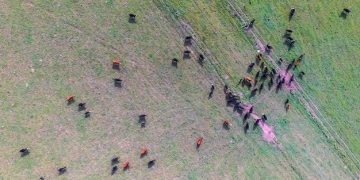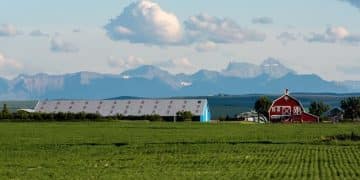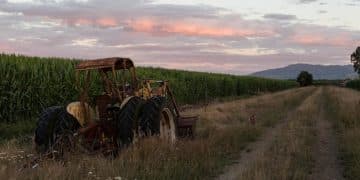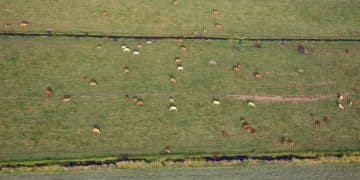Key Strategies for Reducing Greenhouse Gas Emissions in Agriculture

Reducing greenhouse gas emissions in agricultural operations involves implementing strategies such as improving fertilizer management, adopting conservation tillage, integrating livestock and crop systems, enhancing energy efficiency, and utilizing renewable energy sources.
Agriculture significantly contributes to greenhouse gas emissions, but adopting sustainable practices can dramatically reduce this impact. Understanding what are the key strategies for reducing greenhouse gas emissions in agricultural operations is crucial for creating a more sustainable and environmentally friendly food production system.
Understanding Greenhouse Gas Emissions in Agriculture
Agriculture is both a victim and a contributor to climate change. Understanding the sources and types of greenhouse gas emissions from agricultural activities is the first step towards mitigation. These emissions primarily include carbon dioxide (CO2), methane (CH4), and nitrous oxide (N2O).
Sources of Emissions
Agricultural emissions come from a variety of sources, making it a complex issue to tackle. These sources include:
- Fertilizer Use: Synthetic nitrogen fertilizers release nitrous oxide, a potent greenhouse gas.
- Livestock Management: Ruminant animals produce methane through enteric fermentation.
- Tillage Practices: Conventional tillage can release carbon stored in the soil.
- Energy Consumption: Farm machinery, irrigation, and heating systems rely on fossil fuels.
By identifying these sources, targeted strategies can be developed to minimize their environmental impact.

Improving Fertilizer Management
Efficient fertilizer management is critical for reducing nitrous oxide emissions. This involves optimizing the amount, timing, and placement of fertilizers to match crop needs, minimizing losses to the environment. Precision agriculture techniques play a key role here.
Precision Agriculture Techniques
Precision agriculture uses data-driven approaches to optimize fertilizer application. Key techniques include:
- Variable Rate Application: Applying fertilizer only where and when needed based on soil conditions and crop requirements.
- Soil Testing: Regularly testing soil to determine nutrient levels and adjust fertilizer inputs accordingly.
- Remote Sensing: Using drones or satellites to monitor crop health and identify areas needing additional nutrients.
These technologies ensure that fertilizers are used efficiently, reducing both environmental impact and input costs.
Adopting Conservation Tillage
Conservation tillage practices aim to minimize soil disturbance, which helps to keep carbon stored in the soil. This not only reduces greenhouse gas emissions but also improves soil health, water retention, and biodiversity. No-till farming is a prime example.
Benefits of No-Till Farming
No-till farming offers several environmental and economic benefits:
- Carbon Sequestration: Reduces CO2 emissions by keeping carbon in the soil.
- Reduced Erosion: Minimizes soil loss, protecting water quality.
- Improved Soil Health: Enhances soil structure, water infiltration, and nutrient cycling.
Additionally, conservation tillage can reduce fuel consumption and labor costs, making it an economically attractive option for farmers.
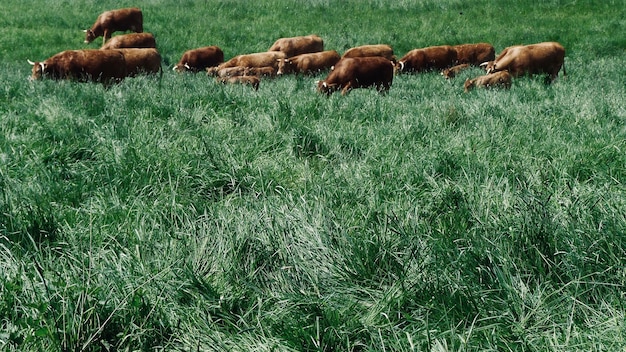
Integrating Livestock and Crop Systems
Integrating livestock and crop systems can create synergistic effects that reduce greenhouse gas emissions and improve overall farm sustainability. This approach involves using livestock manure as fertilizer, rotating crops to improve soil health, and implementing rotational grazing practices.
Rotational Grazing
Rotational grazing involves moving livestock between different pastures to prevent overgrazing and promote forage growth. Benefits include:
- Improved Soil Health: Manure fertilizes the soil, enhancing its fertility and carbon content.
- Reduced Fertilizer Use: Less reliance on synthetic fertilizers due to natural nutrient cycling.
- Enhanced Carbon Sequestration: Healthier pastures sequester more carbon from the atmosphere.
This holistic approach improves productivity and environmental outcomes simultaneously.
Enhancing Energy Efficiency
Agriculture relies heavily on energy for various operations, from powering machinery to running irrigation systems. Enhancing energy efficiency can significantly reduce greenhouse gas emissions by minimizing fossil fuel consumption. This includes using more efficient equipment and optimizing operational practices.
Strategies for Energy Efficiency
Farmers can implement several strategies to improve energy efficiency:
- Efficient Irrigation Systems: Using drip irrigation or other water-saving technologies.
- Optimized Machinery Use: Regularly maintaining equipment and using fuel-efficient models.
- Building Insulation: Insulating farm buildings to reduce heating and cooling needs.
These upgrades not only reduce emissions but also lower energy costs, increasing profitability.
Utilizing Renewable Energy Sources
Transitioning to renewable energy sources is a long-term solution for reducing greenhouse gas emissions in agriculture. Solar, wind, and biogas are viable options that can power farm operations, reducing reliance on fossil fuels.
Renewable Energy Options
Farmers can adopt various renewable energy technologies:
- Solar Panels: Generate electricity for farm operations, such as irrigation and lighting.
- Wind Turbines: Produce electricity to power farm machinery and buildings.
- Biogas Digesters: Convert manure and crop residues into biogas, which can be used for heating and electricity.
These investments not only reduce environmental impact but also provide a stable and sustainable energy supply.
Carbon Sequestration Techniques
Carbon sequestration involves capturing and storing atmospheric carbon in the soil, vegetation, or other reservoirs. Agricultural practices such as afforestation, cover cropping, and biochar application can enhance carbon sequestration, turning farms into carbon sinks.
Methods for Carbon Sequestration
Several techniques can be employed to sequester carbon:
- Afforestation: Planting trees on agricultural land to absorb CO2.
- Cover Cropping: Planting crops specifically to improve soil health and sequester carbon.
- Biochar Application: Adding biochar (charcoal produced from biomass) to the soil to enhance carbon storage.
These practices improve soil health, enhance biodiversity, and mitigate climate change.
| Key Point | Brief Description |
|---|---|
| 🌱 Fertilizer Management | Optimize fertilizer use to reduce nitrous oxide emissions. |
| 🚜 Conservation Tillage | Minimize soil disturbance to keep carbon stored in the soil. |
| 🐄 Livestock Integration | Use livestock manure as fertilizer and implement rotational grazing. |
| ⚡ Renewable Energy | Utilize solar, wind, and biogas to power farm operations. |
Frequently Asked Questions
▼
The main sources are synthetic nitrogen fertilizers, which release nitrous oxide, and livestock, which produce methane. Tillage practices and energy consumption also contribute significantly.
▼
Conservation tillage minimizes soil disturbance, allowing carbon to stay stored in the soil. This reduces the release of carbon dioxide into the atmosphere and improves soil health.
▼
Integrating livestock and crop systems allows for the use of manure as fertilizer, reducing reliance on synthetic fertilizers. Rotational grazing also improves soil health and carbon sequestration.
▼
Solar panels, wind turbines, and biogas digesters are all viable renewable energy sources for agricultural operations. These can power machinery, irrigation systems, and farm buildings.
▼
Carbon sequestration techniques, such as afforestation, cover cropping, and biochar application, capture and store atmospheric carbon in the soil, turning farms into carbon sinks and reducing overall emissions.
Conclusion
Reducing greenhouse gas emissions in agricultural operations requires a multifaceted approach that includes improving fertilizer management, adopting conservation tillage, integrating livestock and crop systems, enhancing energy efficiency, and utilizing renewable energy sources. By implementing these strategies, farmers can contribute to a more sustainable and climate-friendly food production system.


